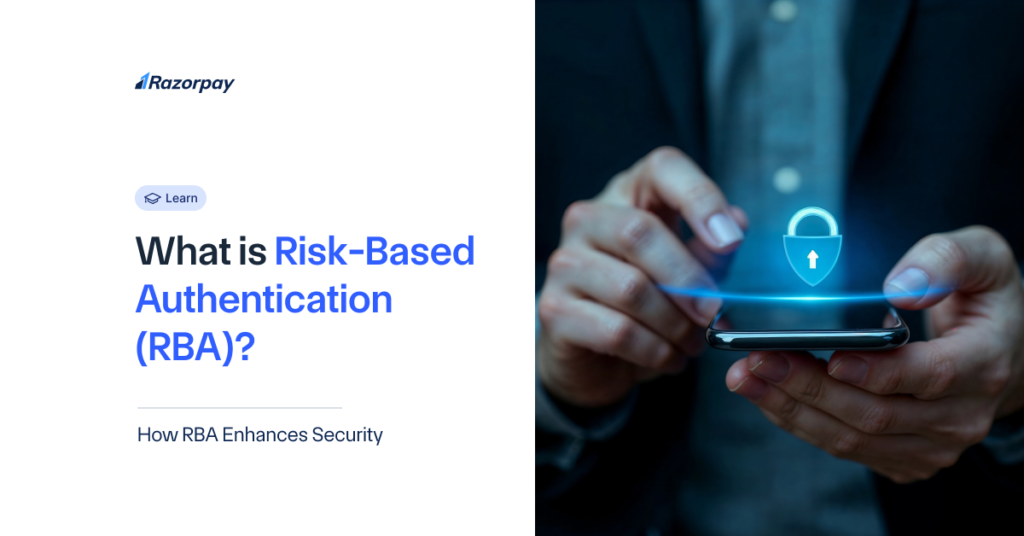Risk Based Authentication (RBA) is a dynamic security approach that adapts the authentication process based on the perceived risk level of a user’s login attempt or transaction. By analysing various risk factors such as geographic location, IP address, device information, user behaviour patterns, and the sensitivity of the requested information, RBA risk-based authentication systems can calculate a risk score and adjust the authentication requirements accordingly.
The importance of risk based authentication in today’s digital landscape cannot be overstated. With the increasing sophistication of cyber threats and the growing reliance on online services, organisations need to move away from traditional security methods and implement robust security measures that can effectively protect user accounts and sensitive data.
Table of Contents
What is Risk Based Authentication (RBA)?
Risk-Based Authentication (RBA) is an advanced security mechanism that dynamically adjusts the authentication requirements based on the perceived risk associated with a user’s login attempt or transaction. Unlike traditional static authentication methods that rely on fixed factors like passwords, risk-based multi-factor authentication takes into account a wide range of contextual factors to determine the appropriate level of authentication needed.
RBA systems continuously monitor and analyse various risk indicators, such as:
- Geographic location
- IP address
- Device information (e.g., operating system, device ID)
- User behaviour patterns
- Network risk
- Sensitivity of the requested information
By evaluating these factors in real-time, RBA risk-based authentication can assess the likelihood of a login attempt or transaction being fraudulent or malicious. Based on the calculated risk score, the system can then adapt the authentication process, requiring additional verification steps for high-risk scenarios while streamlining access for low-risk ones.
How Does Risk Based Authentication Work?
- The user initiates the login process by providing their username and password or other primary authentication factors.
- The RBA system collects and evaluates a range of contextual data points associated with the login attempt, such as the user’s location, device, network, and behaviour patterns.
- Based on the analysis of the risk factors, the RBA system assigns a risk score to the login attempt. This score quantifies the likelihood of the attempt being fraudulent or malicious.
- Depending on the calculated risk score, the RBA system dynamically adjusts the authentication requirements. Low-risk attempts may be granted access without additional verification, while medium and high-risk attempts may trigger additional authentication steps.
- If the user successfully completes the required authentication steps, access is granted to the requested resource or service. If the user fails to satisfy the authentication requirements or the risk is deemed too high, access may be denied.
Low-Risk Connections in RBA
Low-risk connections in RBA authentication are typically associated with familiar and trusted scenarios, such as:
- Logging in from a known device or location
- Accessing the system through a secure Virtual Private Network (VPN) connection
- Exhibiting consistent and expected user behaviour patterns
In these cases, the RBA system may grant access without requiring additional authentication steps, providing a seamless and frictionless user experience.
Medium-Risk Connections in RBA
Medium-risk connections in risk based multi-factor authentication may involve scenarios where some aspects of the login attempt raise potential concerns, such as:
- Logging in from an unfamiliar device or location
- Accessing the system from a new or infrequently used IP address
- Attempting to perform transactions or access resources that deviate from the user’s typical behaviour
In such cases, the RBA system may prompt the user to provide additional information or complete extra authentication steps, such as answering security questions, confirming their email address, or entering a one-time password (OTP) sent to their registered mobile device.
High-Risk Connections in RBA
High-risk connections in RBA risk based authentication are characterised by suspicious or anomalous factors that significantly increase the likelihood of fraudulent activity, such as:
- Logging in from a known high-risk location or during unusual hours
- Attempting to perform high-value or sensitive transactions that are out of character for the user
- Exhibiting behaviour patterns that strongly deviate from the user’s established norm
In these high-risk scenarios, the RBA system may require the user to complete multiple additional authentication factors, such as biometric verification (e.g., fingerprint or facial recognition), hardware token validation, or even manual intervention by security personnel. In some cases, access may be outright denied to protect the integrity of the system and the user’s account.
Key Benefits of Risk Based Authentication
Implementing risk based authentication offers several key benefits to organisations, including:
1. Improved security posture:
By dynamically adapting authentication requirements based on real-time risk assessments, RBA helps organisations reduce the risk of account takeover, data breaches, and fraudulent transactions.
2. Enhanced user experience:
RBA minimises friction for legitimate users by streamlining authentication processes in low-risk scenarios while applying additional security measures only when necessary. This balance between security and usability leads to a more positive user experience.
3. Customisable risk policies:
Organisations can tailor their RBA risk policies to align with their specific security requirements, risk appetite, and regulatory obligations. This flexibility allows for fine-grained control over authentication flows and risk mitigation strategies.
4. Reduced operational costs:
RBA authentication can help organisations optimise their authentication processes, reducing the need for manual interventions and lowering the operational overhead associated with managing and resetting user credentials.
5. Compliance enablement:
RBA supports compliance with various security and privacy regulations, such as GDPR, HIPAA, and PCI DSS, by providing a robust and adaptable authentication framework that meets stringent security requirements.
Types of Risk-Based Authentication Models
There are different types of Risk Based Authentication models, each with its own focus and approach:
1. Adaptive Risk-Based Authentication (ARBA):
ARBA systems continuously learn and adapt to user behaviour over time. As the system becomes more familiar with a user’s typical patterns, it can progressively refine its risk assessments and authentication decisions.
2. Continuous Risk-Based Authentication (CRBA):
CRBA extends the risk assessment process beyond the initial login by continuously monitoring user activity throughout the session. If suspicious behaviour is detected, the system can prompt for additional authentication or even terminate the session.
3. User-Dependent RBA:
This model applies a consistent authentication policy to each user based on their individual risk profile. The authentication requirements remain relatively stable for a given user unless significant changes in behaviour or risk factors occur.
4. Transaction-Dependent RBA:
In this model, the authentication requirements vary based on the specific transaction or action being performed, even for the same user. High-risk or sensitive transactions may require stronger authentication compared to low-risk ones.
Factors Determining Risk in RBA
Risk-based authentication RBA systems consider a wide range of factors to determine the risk level associated with a login attempt or transaction. Some of the key factors include:
- Geographic location: Unusual or high-risk locations may indicate potential fraud.
- IP address: Suspicious or unfamiliar IP addresses may raise red flags.
- Device information: New or untrusted devices may require additional scrutiny.
- User behaviour patterns: Deviations from typical behaviour, such as accessing the system at odd hours or performing unusual transactions, may indicate risk.
- Network characteristics: Connections from unsecured or compromised networks may be treated as higher risk.
- Contextual data: Other relevant data points, such as the user’s role, permissions, and transaction history, can contribute to the risk assessment.
Common Use Cases of Risk-Based Authentication
Risk based multi-factor authentication finds application across various industries and use cases, including:
1. Online banking and financial services:
RBA helps secure online banking portals, detect fraudulent transactions, and protect sensitive financial data.
2. E-commerce platforms:
RBA can prevent account takeovers, unauthorised purchases, and identity theft in online retail environments.
3. Healthcare systems:
RBA enables secure access to electronic health records (EHRs) and ensures compliance with privacy regulations like HIPAA.
4. Enterprise applications:
RBA can safeguard corporate data and resources by enforcing risk based access controls for employees, partners, and contractors.
The Role of Biometrics and Adaptive Authentication in RBA
Biometric authentication and adaptive authentication are two key technologies that can enhance the effectiveness of RBA risk-based authentication:
1. Biometric authentication:
Biometric factors, such as fingerprints, facial recognition, or voice recognition, provide a strong and unique identifier for users. Integrating biometrics into RBA flows can significantly increase the assurance level of high-risk authentication scenarios.
2. Adaptive authentication:
Adaptive authentication technologies continuously learn and adapt to user behaviour over time. By analysing patterns and anomalies, adaptive authentication can refine risk assessments and authentication decisions, reducing false positives and improving the overall user experience.
Conclusion
Risk Based Authentication is a powerful security approach that enables organisations to dynamically adapt authentication requirements based on the real-time assessment of login or transaction risk. By considering a wide range of contextual factors and leveraging advanced technologies like biometrics and adaptive authentication, RBA authentication helps organisations strike the right balance between security and usability.
Implementing risk-based authentication offers numerous benefits, including improved security posture, enhanced user experience, customisable risk policies, reduced operational costs, and compliance enablement. As cyber threats continue to evolve and user expectations for seamless digital experiences rise, adopting risk-based multi-factor authentication becomes increasingly crucial for organisations across industries.
Frequently Asked Questions (FAQs):
1. How does RBA improve security?
RBA improves security by dynamically adapting authentication requirements based on the assessed risk of each login attempt or transaction. By requiring additional verification steps for high-risk scenarios and streamlining authentication for low-risk ones, RBA helps prevent unauthorised access and fraud while maintaining a user-friendly experience.
2. Is Risk Based Authentication suitable for all businesses?
Risk based authentication RBA can be beneficial for businesses of all sizes and industries that require secure access to digital assets and sensitive data. However, the specific implementation and configuration of RBA may vary depending on the organisation’s security needs, risk appetite, and regulatory requirements.
3. What happens if I fail the RBA checks?
If a user fails to satisfy the authentication requirements imposed by the RBA risk based authentication system, access to the requested resource or service may be denied. In some cases, additional authentication steps may be required, or the user may be prompted to contact support for further assistance.
4. Does RBA work on mobile apps?
Yes, RBA authentication can be implemented in mobile apps to secure access to sensitive data and functionality. Mobile-specific risk factors, such as device fingerprinting, geolocation, and app integrity checks, can be incorporated into the RBA risk assessment process.
5. What is the difference between traditional authentication and risk-based authentication?
Traditional authentication relies on static factors, such as passwords or security questions, to verify a user’s identity. In contrast, risk-based multi-factor authentication dynamically adjusts the authentication requirements based on the assessed risk of each login attempt or transaction, taking into account a wide range of contextual factors beyond just the user’s credentials.


